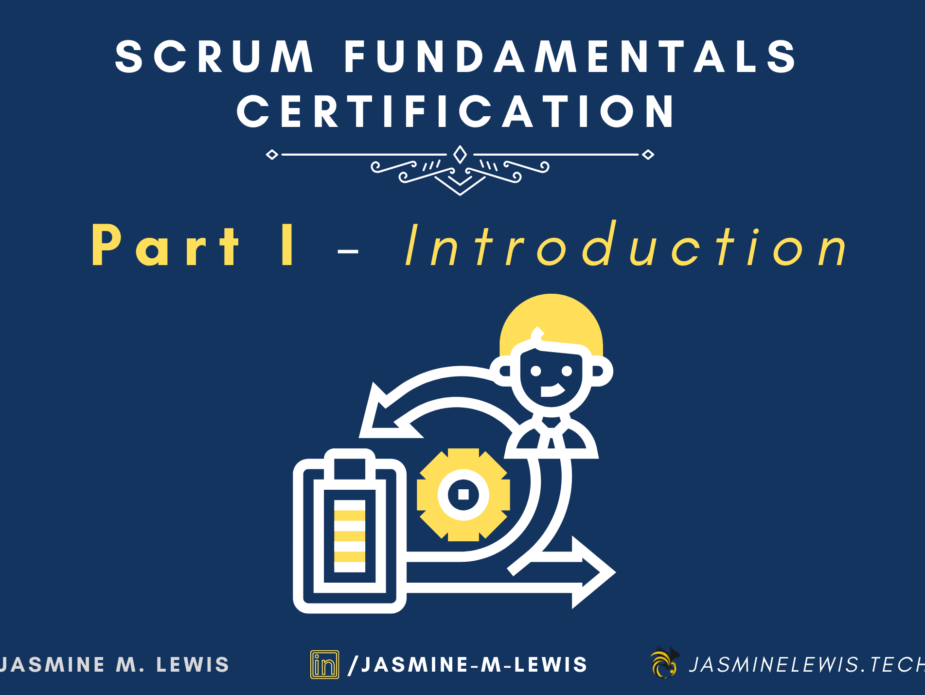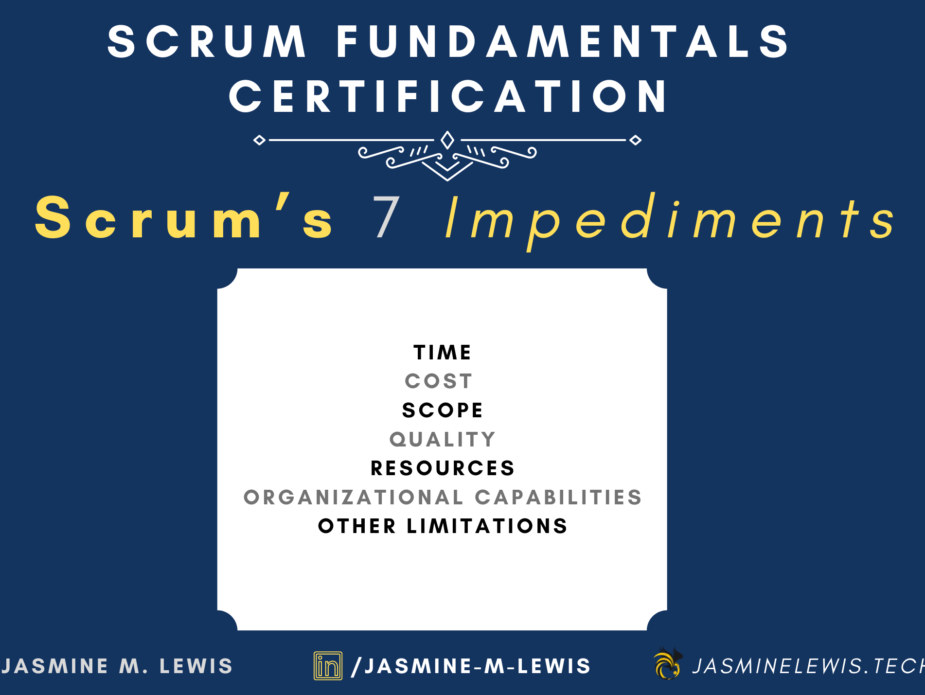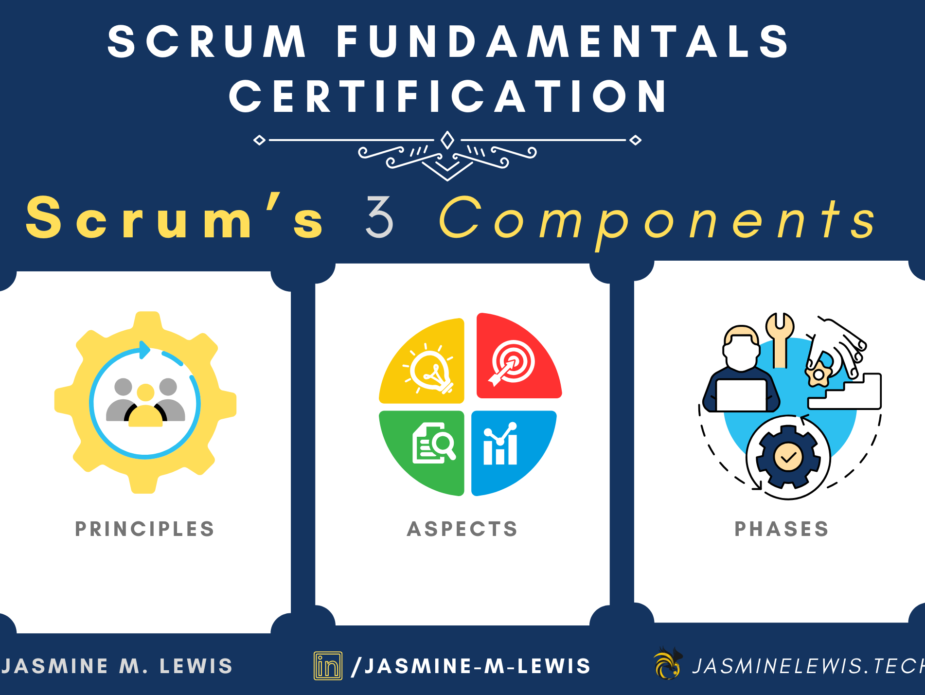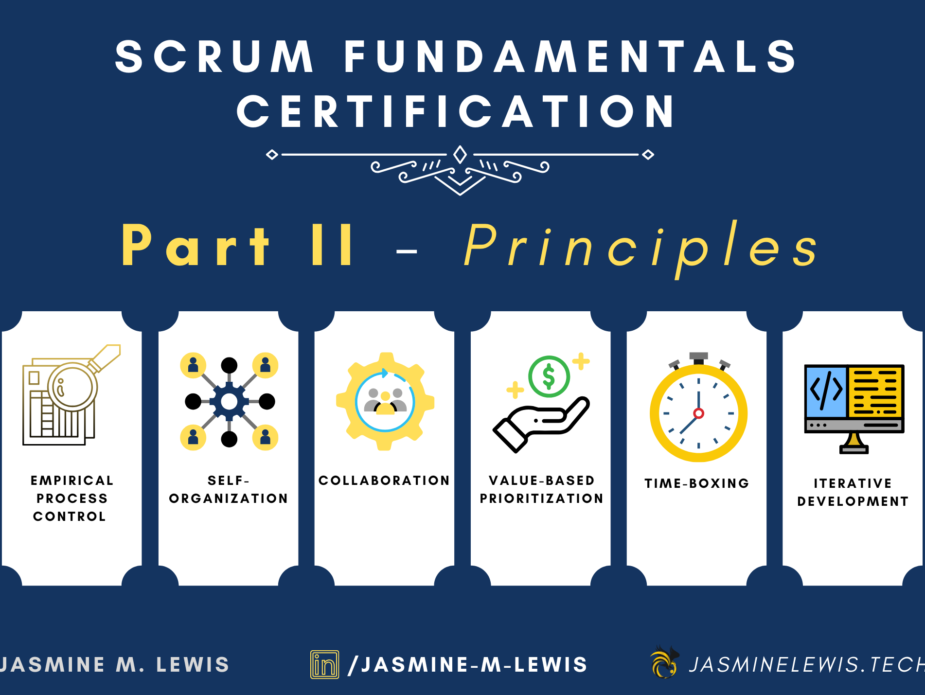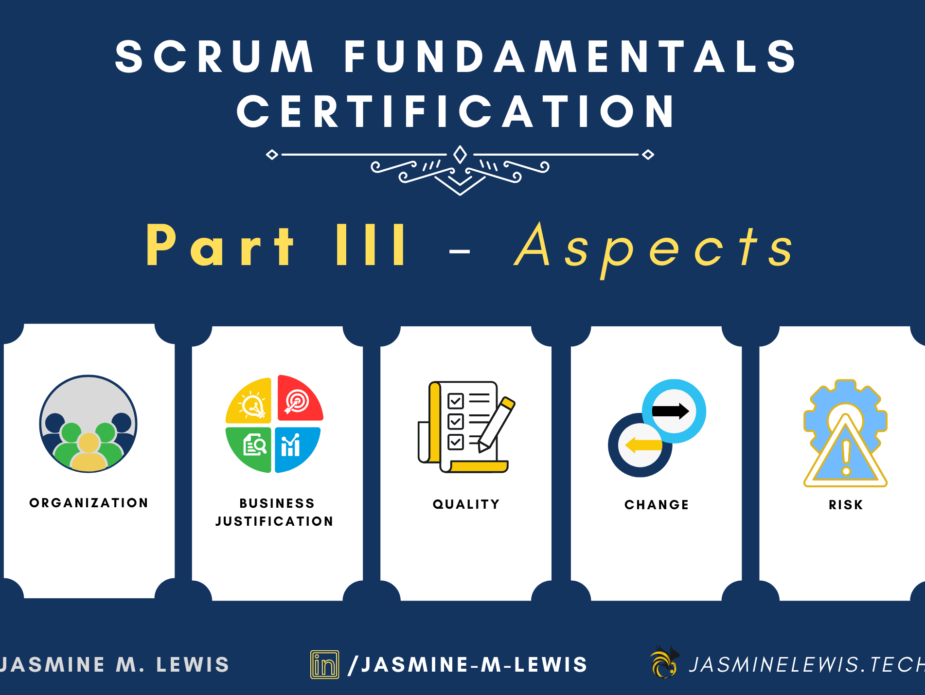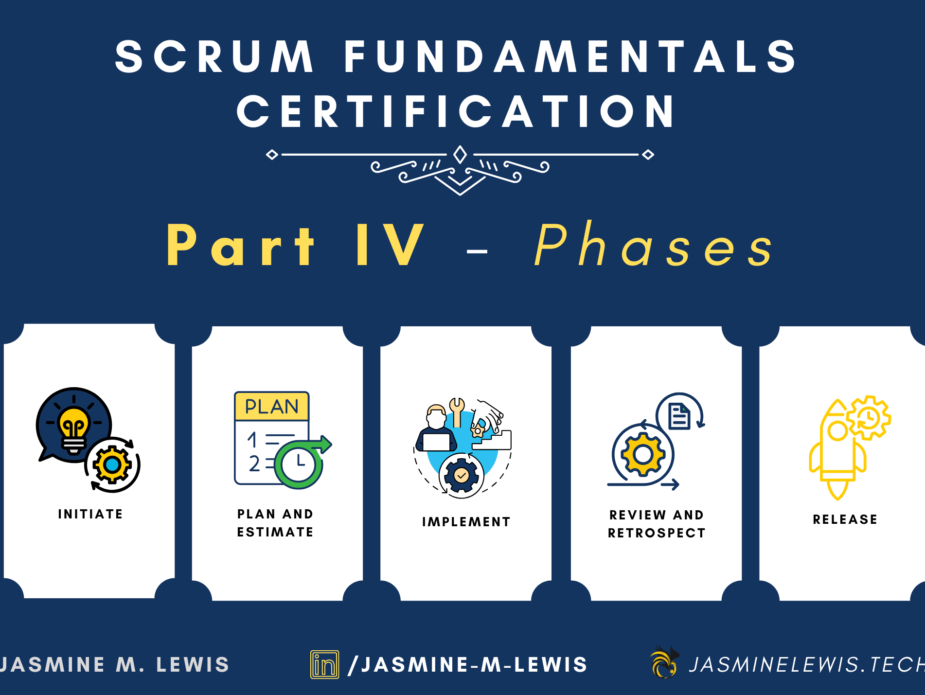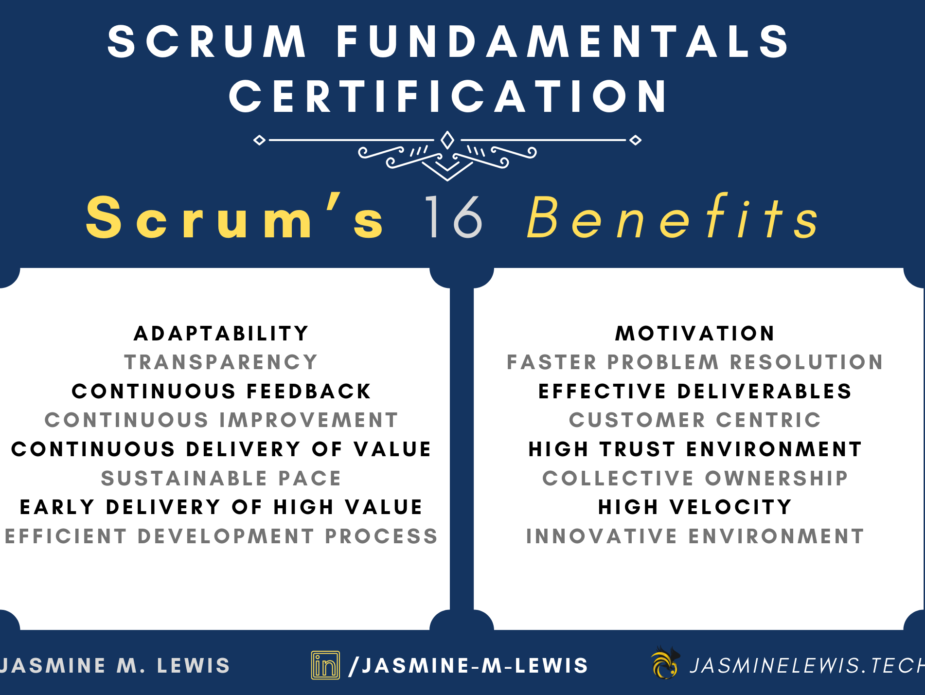Scrum Fundamentals Certification (SFC) | Study Guide – Part I: Introduction
Learn about SCRUMstudy’s Scrum Fundamentals Certification (SFC) synopsis, overview of scrum, its principles, aspects, phases, benefits, and impediments.
Greetings & Salutations, Artistikk R3b3lls!
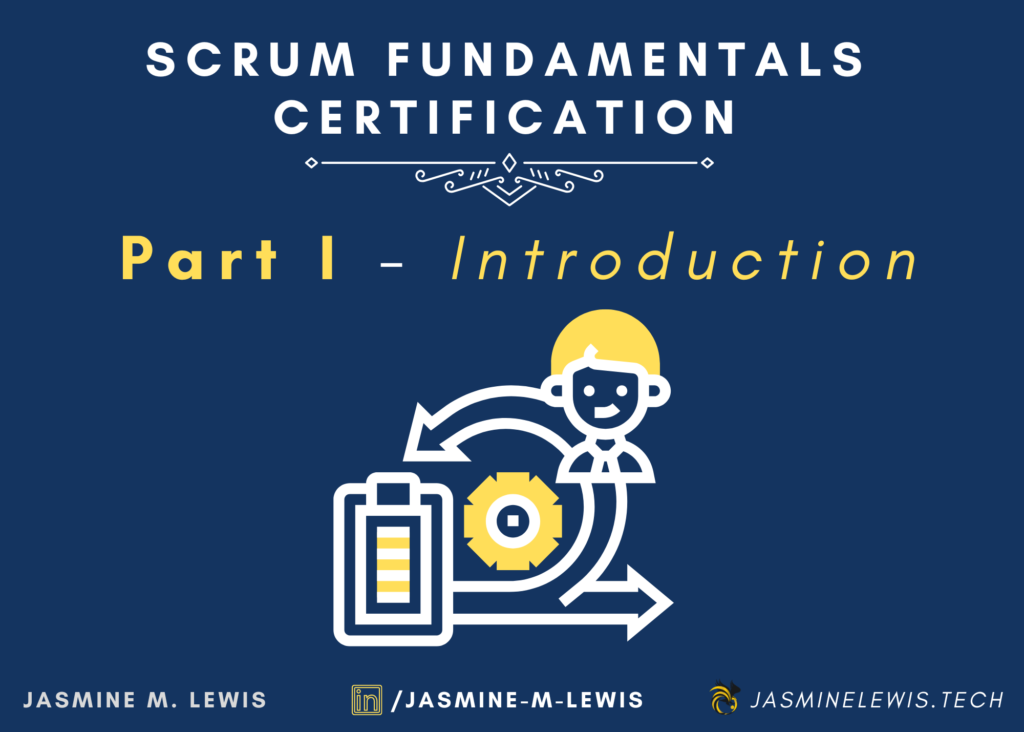
Study Guide Overview
I am pursuing my SCRUMstudy’s Scrum Fundamentals Certification (SFC). I am taking this course and exam because it introduces the Scrum framework. Scrum is a framework within agile methodology commonly used more than Waterfall that can be used to implement simple and complex projects. In this article titled Scrum Fundamentals Certification (SFC) | Study Guide – Part I : Introduction, I provide a synopsis of the examination, an overview of scrum, its principles, aspects, phases, benefits, and impediments.
Note
All Scrum definitions, images, and related text in the Scrum Book of Knowledge (SBOK) 4th Edition are taken from SCRUMstudy, a brand of VMEdu, Inc courses. Content obtained from the SBOK will state the page for reference. This is article is intended for informational and educational purposes.
Study Guide Contents
My SFC Exam Study Guide are comprised of eight sections:
- Part I: Introduction
- Part II: Scrum Principles
- Part III: Scrum Aspects
- Part IV: Scrum Phases & Processes
- Part V: Scaling Scrum
- Part VI: Glossary
- Part VII: Practice Test
- Practice Test 1.1
- Practice Test 1.2
- Practice Test 1.3
- Part VIII: Case Study
- Case Study – Phase 1
- Case Study – Phase 2
- Case Study – Phase 3
- Case Study – Phase 4
- Case Study – Phase 5
As I study to complete the SCRUMstudy’s Scrum Fundamentals Certification (SFC), I will compile study notes into articles and share them with everyone. Yep-pey :)
Let the page-turning commence!
Scrum Fundamentals Certification
The Scrum Fundamentals Certification (SFC) is an introductory certification for individuals interested in learning project and software development processes using Agile methodology. The SFC is provided by SCRUMstudy – the Global Accreditation Body for Scrum and Agile Certifications. There are not any prerequisites for experience or education to prepare for the course. An additional benefit of acquiring this certification is its valid for a lifetime.
Examination Format
The exam format consists of the following:
- Multiple choice
- 40 questions per exam
- One mark awarded for every right answer
- No negative marks for wrong answers
- 30 questions need to be answered correctly to pass
- 60 minutes duration
- Online non-proctored exam
- Can be attempted multiple times for free
Examination Topics
The exam format consists of the following:
- Scrum Principles
- Scrum Aspects
- Scrum Phases & Processes
- Scaling Scrum
Overview of Scrum
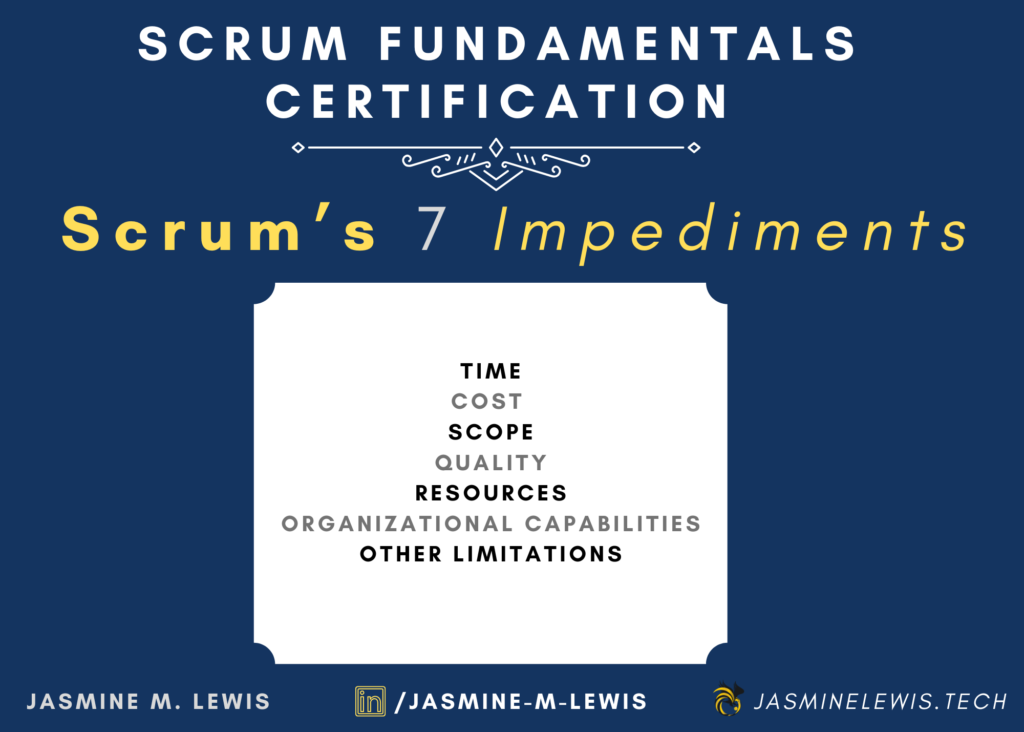
What is Scrum?
Scrum is one of the most popular Agile methodologies. It delivers value throughout a project expeditiously due to its adaptative, iterative, fast, flexible, and effective framework.
Agile Methodologies
Agile methodologies are focused on the four factors:
- Value Driven Delivery
- Adaptive Planning
- Continuous Improvement
- Active Stakeholder Engagement
Scrum Impediments
A Scrum project involves a collaborative effort to create a new product, service, or other result as defined in the Project Vision Statement. Projects are impacted by impediments that makes it difficult for teams to plan, implement, manage, and deliver. Project impediments include the following:
- Time
- Cost
- Scope
- Quality
- Resources
- Organizational Capabilities
- Other limitations
Reference | Scrum Body of Knowledge, SBOK Guide | 4th Edition | Chapter: Introduction | Page: 2
Scrum Components
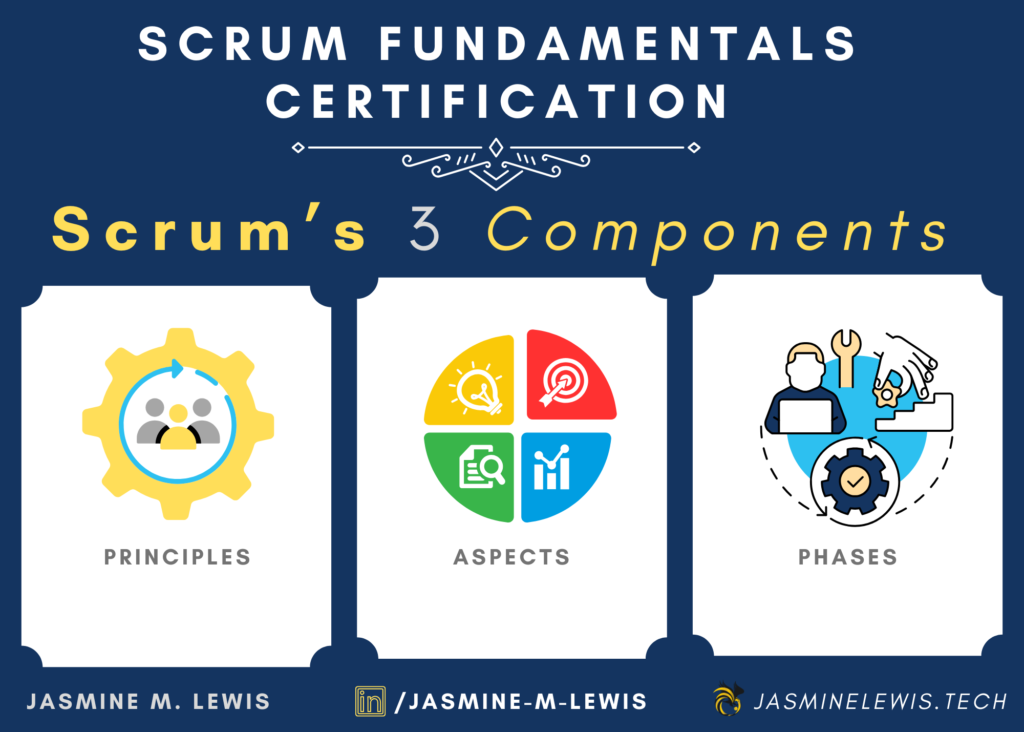
Scrum Components
Scrum consist of three primary components: principles, aspects, and phases. SCRUMstudy’s Scrum Body of Knowledge, SBOK Guide is divided the into three areas:
- Principles (Chapter 2)
- Aspects (Chapters 3 – 7)
- Phases (Chapters 8-– 12)
Reference | Scrum Body of Knowledge, SBOK Guide | 4th Edition | Chapter: Introduction | Page: 7
Scrum Principles
Scrum consists of six principles:
- Empirical Process Control
- Self-Organization
- Collaboration
- Value-based Prioritization
- Time-boxing
- Iterative Development
Reference | Scrum Body of Knowledge, SBOK Guide | 4th Edition | Chapter: Introduction | Page: 9
Scrum Aspects
Scrum consists of five aspects:
- Organization
- Business Justification
- Quality
- Change
- Risk
Reference | Scrum Body of Knowledge, SBOK Guide | 4th Edition | Chapter: Introduction | Page: 11 – 14
Scrum Phases
Scrum consists of five phases:
- Initiate
- Plan and Estimate
- Implement
- Review and Retrospect
- Release
Reference | Scrum Body of Knowledge, SBOK Guide | 4th Edition | Chapter: Introduction | Page: 15
Scrum Principles
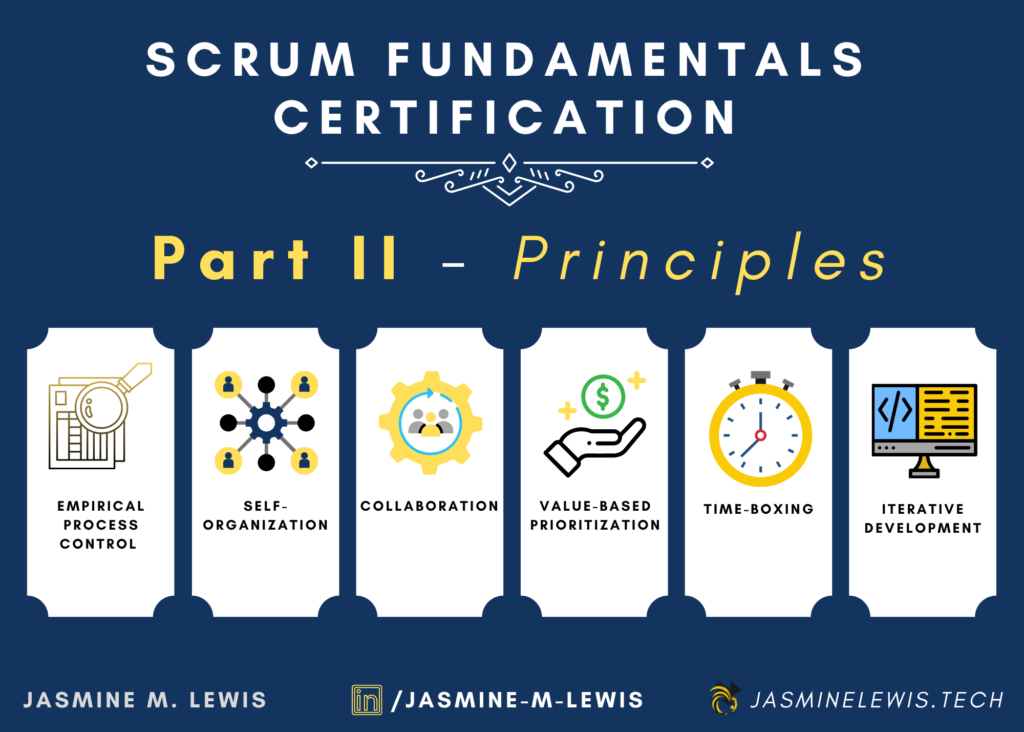
Empirical Process Control
An Empirical Process Control model helps make decisions based on observation and experimentation rather than on detailed upfront planning. It relies on the three main ideas of transparency, inspection, and Adaptation.
Reference | Scrum Body of Knowledge, SBOK Guide | 4th Edition | Chapter: Glossary | Page: 363
Self-Organization
Scrum believes that employees are self-motivated and seek to accept greater responsibility. Hence, they deliver much greater value when self-organized.
Reference | Scrum Body of Knowledge, SBOK Guide | 4th Edition | Chapter: Glossary | Page: 384
Collaboration
Collaboration in Scrum refers to the Scrum Core Team working together and interfacing with the stakeholders to create and validate the deliverables of the project to meet the goals outlined in the Project Vision. Collaboration occurs when a team works together to play off each other’s contributions to produce something greater.
Reference | Scrum Body of Knowledge, SBOK Guide | 4th Edition | Chapter: Glossary | Page: 358
Value-based Prioritization
Scrum, however, uses Value-based Prioritization as one of the core principles that drives the structure and functionality of the entire Scrum framework—it helps projects benefit through adaptability and iterative development of the product or service. More significantly, Scrum aims at delivering a valuable product or service to the customer on an early and continuous basis.
Reference | Scrum Body of Knowledge, SBOK Guide | 4th Edition | Chapter: Principles | Page: 33
Time-boxing
Time-boxing refers to setting short periods of time for work to be done. If the work undertaken remains incomplete at the end of the Time-box, it is moved into a subsequent Time-box. Time-boxes provide the structure needed for Scrum projects, which have an element of uncertainty, are dynamic in nature, and are prone to frequent changes.
Reference | Scrum Body of Knowledge, SBOK Guide | 4th Edition | Chapter: Glossary | Page: 389
Iterative Development
Iterative Development emphasizes how to better manage changes and build products that satisfy customer needs.
Reference | Scrum Body of Knowledge, SBOK Guide | 4th Edition | Chapter: Introduction | Page: 10
Scrum Aspects
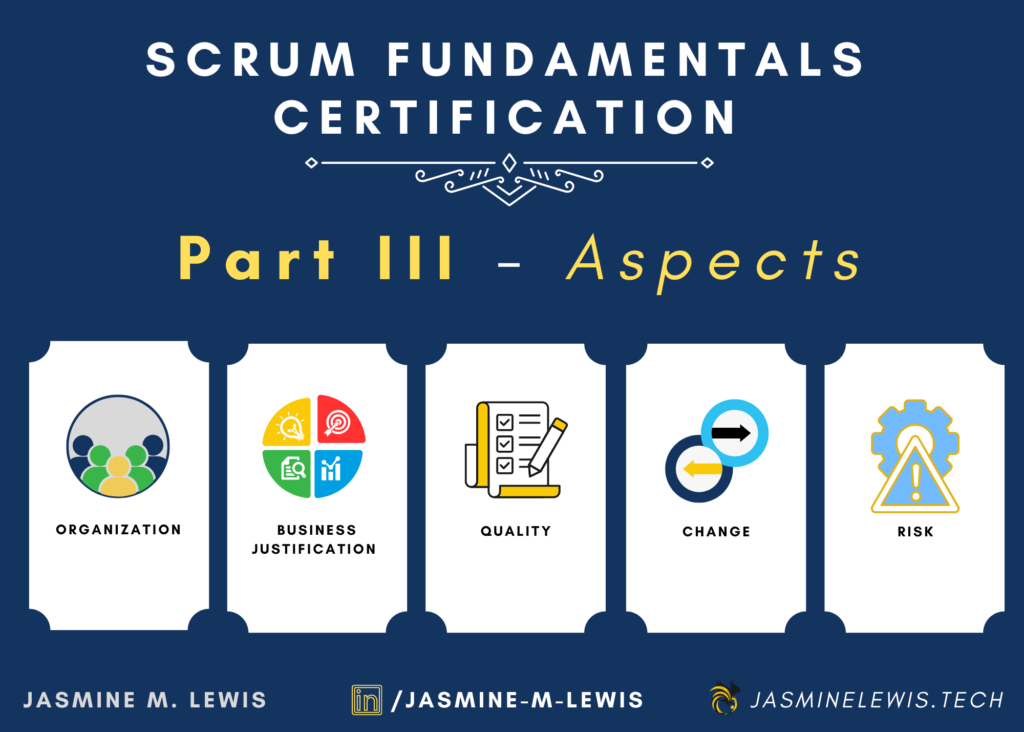
Organization
Organization with Scrum roles fall into two broad categories: core and non-core roles. The Organization aspect of Scrum also addresses the team structure requirements to implement Scrum in large projects, programs, and portfolios.
Reference | Scrum Body of Knowledge, SBOK Guide | 4th Edition | Chapter: Introduction | Page: 11 – 12
Business Justification
Business Justification demonstrates the reasons for undertaking a project. It answers the question “Why is this project needed?” Business justification drives all decision making related to a project.
Reference | Scrum Body of Knowledge, SBOK Guide | 4th Edition | Chapter: Glossary | Page: 357
Quality
Quality is defined as the ability of the completed product or Deliverables to meet the Acceptance Criteria and achieve the business value expected by the customer.
Reference | Scrum Body of Knowledge, SBOK Guide | 4th Edition | Chapter: Glossary | Page: 375
Change
Change is inevitable in all projects. A primary principle of Scrum is its acknowledgement that a) stakeholders (e.g., customers, users, and sponsors) do change their minds about what they want and need throughout a project (sometimes referred to as ‘requirements churn’) and b) that it is very difficult, if not impossible, for stakeholders to define all requirements during project initiation.
Reference | Scrum Body of Knowledge, SBOK Guide | 4th Edition | Chapter: Change | Page: 102
Risk
Risk is defined as an uncertain event or set of events that can affect the objectives of a project and may contribute to its success or failure.
Reference | Scrum Body of Knowledge, SBOK Guide | 4th Edition | Chapter: Glossary | Page: 380
Scrum Phases
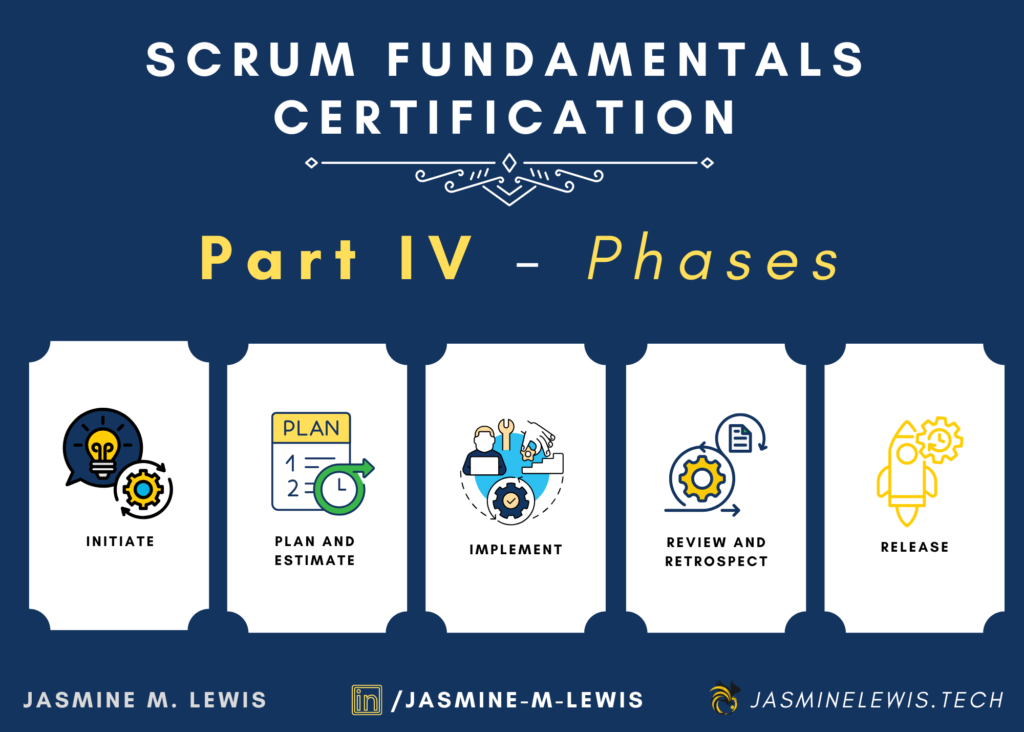
Initiate
This phase is composed of the processes related to initiation of a project: Create Project Vision, Identify Scrum Master and Stakeholder(s), Form Scrum Team, Develop Epic(s), Create Prioritized Product Backlog, and Conduct Release Planning.
Reference | Scrum Body of Knowledge, SBOK Guide | 4th Edition | Chapter: Glossary| Page: 367
Plan and Estimate
The Plan and Estimate phase consist of processes related to planning and estimating tasks, which include Create User Stories, Estimate User Stories, Commit User Stories, Identify Tasks, Estimate Tasks, and Create Sprint Backlog.
Reference | Scrum Body of Knowledge, SBOK Guide | 4th Edition | Chapter: Glossary| Page: 372
Implement
The Implement Phase includes processes related to the execution of the tasks and activities to create a project’s product.
Reference | Scrum Body of Knowledge, SBOK Guide | 4th Edition | Chapter: Glossary | Page: 366
Review and Retrospect
The Review and Retrospect phase is concerned with reviewing the deliverables and the work that has been done and determining ways to improve the practices and methods used to do project work. In large organizations.
Reference | Scrum Body of Knowledge, SBOK Guide | 4th Edition | Chapter: Review and Retrospect | Page: 241
Release
The Release phase emphasizes delivering the Accepted Deliverables to the customer and identifying, documenting, and internalizing the lessons learned during the project.
Reference | Scrum Body of Knowledge, SBOK Guide | 4th Edition | Chapter: Release | Page: 257
Benefits
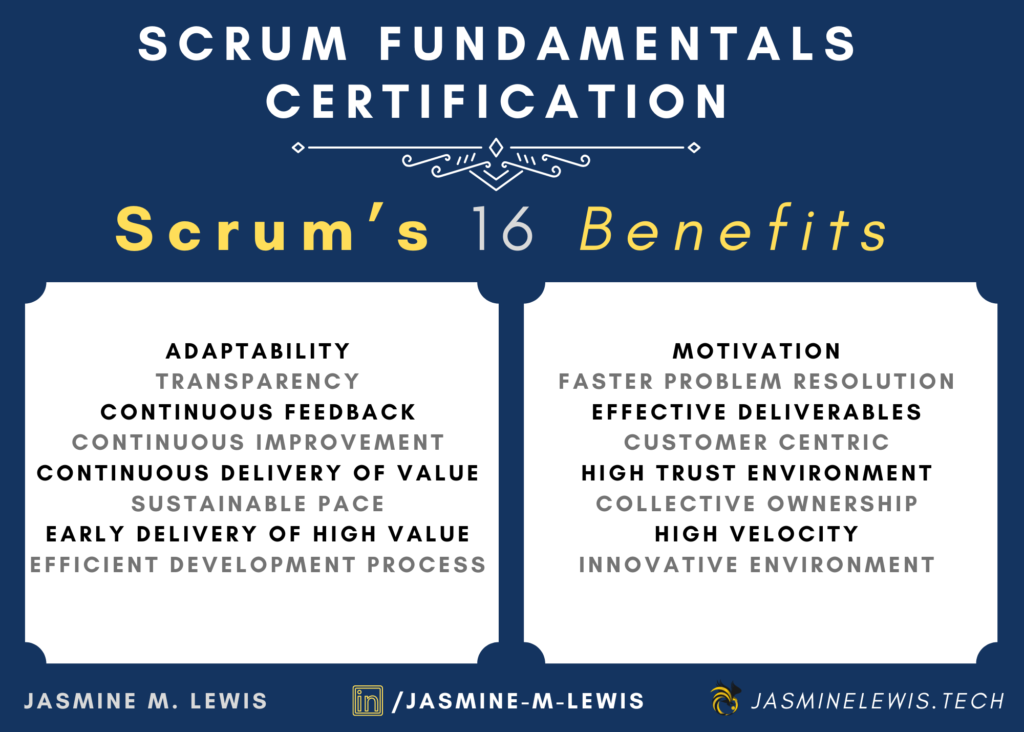
16 Benefits
Scrum consist of 16 benefits. The benefits are the following:
- Adaptability
- Transparency
- Continuous Feedback
- Continuous Improvement
- Continuous Delivery of Value
- Sustainable Pace
- Early Delivery of High Value
- Efficient Development Process
- Motivation
- Faster Problem Resolution
- Effective Deliverables
- Customer Centric
- High Trust Environment
- Collective Ownership
- High Velocity
- Innovative Environment
Adaptability
Empirical Process Control and Iterative Delivery make projects adaptable and open to incorporating change.
Transparency
All information radiators such as Scrum Board and Sprint Burndown Chart are shared, leading to an open work environment.
Continuous Feedback
Continuous Feedback is provided through the Daily Standup and demonstrate and validate Sprint processes.
Continuous Improvement
The deliverables are improved progressively Sprint by Sprint through the Groom Prioritized Product Backlog process.
Continuous Delivery of Value
Iterative processes enable the continuous delivery of value through the Ship Deliverables process as frequently as the customer requires.
Sustainable Pace
Scrum processes are designed such that the people involved can work at a sustainable pace that they can, in theory, continue indefinitely.
Early Delivery of High Value
The Create Prioritized Product Backlog process ensures that the highest value requirements of the customer are satisfied first.
Efficient Development Process
Time-boxing and minimizing non-essential work leads to higher efficiency levels.
Motivation
The Daily Standup and Retrospect Sprint processes lead to greater levels of motivation among employees.
Faster Problem Resolution
Collaboration and colocation of cross-functional teams lead to faster problem solving.
Effective Deliverables
The create Prioritized Product Backlog process and regular reviews after creating deliverables ensures effective deliverables to the customer.
Customer Centric
Emphasis on business value and having collaborative approach to stakeholders ensures a customer-oriented framework.
High Trust Environment
Conduct Daily Standup and Retrospect Sprint processes promote transparency and collaboration, leading to a high trust work environment ensuring low friction among employees.
Collective Ownership
The Commit User Stories process allows team members to take ownership of the project and their work leading to better quality.
High Velocity
A collaborative framework enables highly skilled cross-functional teams to achieve their full potential and high velocity.
Innovative Environment
The Retrospect Sprint and Retrospect Project processes create an environment of introspection, learning, and adaptability leading to an innovative and creative work environment.
Reference | Scrum Body of Knowledge, SBOK Guide | 4th Edition | Chapter: Introduction | Page: 4
Conclusion
I highly recommend anyone interested in learning the process of software development or project management to take SCRUMstudy’s Scrum Fundamentals Certification (SFC) exam. In this section, Scrum Fundamentals Certification (SFC) | Study Guide – Part I: Introduction, I provided a synopsis of the examination, an overview of scrum, its principles, aspects, phases, benefits, and impediments.
Until next time: learning Scrum methodology will assist you in completing all types of projects, not only software applications.
R3b3l with me at GitHub, Medium, Dev Community, and LinkedIn
Signed
The LightBringer
I am the eagle that flies ABOVE.

